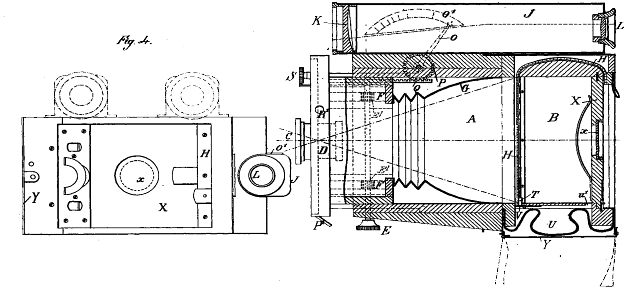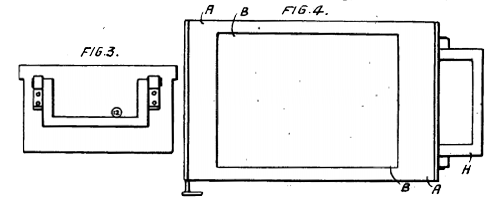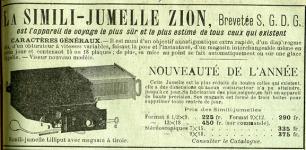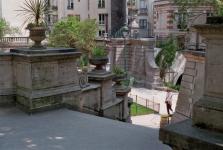|
Zion Lilliput |
Manufactured or assembled in France from (Before) 1898 to (After) 1899.
Index of rarity in France: Rare (among non-specialized garage sales)
Inventory number: 13533
See the complete technical specifications
Chronology of cameras Zion
It is a improved and simplified model of the Simili-Jumelle from the optician Zion. The Lilliput jumelle camera is provided with an anastigmatic lens made of Iena glass of a very great sharpness and a very great depth, which makes it possible to take picture, even during weather without sun, and which is mounted on a sophisticated air and piston central shutter of a special model..
The system of retraction of the plates of the magazine is based on an absolutely new and reliable principle, which with a little practice allows to avoid failures.
| 6,5 x 9 | 9 x 12 | |
|
|
||
| Weight with 18 slim plates or 15 thick (g.) | 1500 | 2250 |
| Heigh (mm) | 120 | 145 |
| Width (mm) | 130 | 160 |
| Thickness (mm) | 85 | 110 |
| Price with iris diaphragm and improved shutter for I and P (francs) |
225 | 290 |
(Photo-Revue 1898)
The right name is Lilliput and not Liput. A typographical error on an advertisement is at the origin of this bad name.
The particularity of this model is that the front plate is fixed on a drawer allowing to save four centimeters on the bulk (for the 9 x 12 format), but of course, at the expense of additional handling. Offered to cyclists, its rarity shows very mixed success ...

Zion history (by Etienne Gérard)
Summary of pages 290 and 291 of Étienne Gérard's book: "Les jumelles photographiques françaises" Club Niépce Lumière ISBN 979-10-91258-05-0 (out of print)
Joseph Zion (5/15/1855 - 10/17/1933) was native of Russia, he settled as a mechanic at 3, rue de quatre fils in Paris. He married there on September 20, 1879 and had six children. He filed the patent for a shutter in 1885, which he manufactured in his workshop at 7 rue de Jouy. He was a member of the SFP (Société Française de Photographie) from 1888 to 1900.
On July 20, 1890, he joined forces with J. Munch in the company J. Zion et Cie operating the Le Factotum brand. Development of a first “Le Cosmos” stereoscopic shutter, and of an anastigmat lens “Anastigmatique” in 1892.
In 1893, patent for the Simili-Jumelle (France and Switzerland) in 6.5 x 9 cm format with presentation to the Photo-Club of Paris (March 7, 1894) and to the SFP (April 6, 1894). The couple Joseph - Jeannette obtained French nationality in December 1894.
In 1896, he filed a patent for a cinema device, the Mouvementoscope, and, with Eugène Gauthier, the patent for the Mouvementograph, a device for processing and projecting animated scenes.
In 1898, he produced a line of detective cameras, partnering with Louis Lazies and Georges Victor to establish an industrial site at 14, rue Pelleport. The association broke up on August 23, 1900 and Joseph Zion moved to 140, boulevard Richard Lenoir. (Bronze medal at the Universal Exhibition of Paris 1900).
He marketed the Stéréo-Bijou, then in 1904, the Zionscopes in a folding version.
Declared bankrupt in October 9, 1909, he was granted a seven-year arrangement on July 29, 1910. In 1911, the Zionscopes series became rigid (6.5 x 9 cm format) and the 4.5 x 6 cm model was of the klapp type . He also produced the Star-Stereo that can be used as a viewer.
End of 1912 - beginning of 1913, he leaves the sale to his eldest son Edmond who settles 30bis, rue Bergère. The latter filed in 1914 a patent for a plate magazine, while his brother Maxime started an apprenticeship in the construction of cameras.
It was in 1913 that the Zionscope 45 x 107mm type H was released, copying the design of the Vérascope, and the Zionscope type V in 6 x 13cm format, as well as a 6.5 x 9cm format model. In 1914, it was the 6 x 13 cm stereo-panoramic Zionscope which was proposed, equipped with the new patented magazine.
During the war, Zion supplied binoculars to the army, and got closer to Photo-Plait which distributed, from 1917 to 1921, the Zionscope 6.5 x 9 cm and the Platoscope 45 x 107mm.
At the end of the war, Edmond moved to 8, rue Haxo, while Joseph released the Pocket (1923) and Pocket Z (1927) in mono 6.5 x 9 cm and stereo 6 x 13 cm. These cameras were equipped with trade lenses.
In 1928, Joseph handed over to his son Edmond, the company becoming: Ed. Zion & Cie, all activities being grouped together at 140, boulevard Richard Lenoir.
Edmond works with his brothers Maxime and Lucien, producing the Pocket Z in mono or stereo klapp type and some stereoscopic jumelles. The company will be declared bankrupt in December 1932.
In 1935, Edmond and Maxime opened an optical store at 90, avenue de Neuilly, in Neuilly s / Seine.
Edmond and his wife were deported to Auschwitz on June 30, 1944 and died there on July 5.
After the war, Maxime and his wife took over the business at 90 Avenue de Neuilly and died there in February 1972.
Lucien died in 1991 at the age of ninety-eight in Le Raincy, in Seine Saint-Denis.
Some patents
Patent n° 7587, filed in Switzerland by Joseph Zion, October 28, 1893, for an automatic viewfinder for cameras of all systems

Patent n° 11 302, filed in UK by Joseph Zion, june 8, 1895, for Simili-Jumelle.

Patent n°338 597, filed by Joseph Zion, décember 31, 1903, for jumelle photographique pliante.

Brevet n° 464 925, déposé par Edmond Zion, le 14 novembre 1913, pour un magasin photographique à tiroir.

Interesting links or bibliography :
 de 1898 |  Photo-Revue de 1898 Le nom est bien Lilliput, et non Liput |
Add a link or element of bibliography, a picture taken with this camera, a picture of box or an ads about this camera
Your photos taken with the same camera:
Cameras from Ebay France (Zion) (Uploaded each 3 hours)








